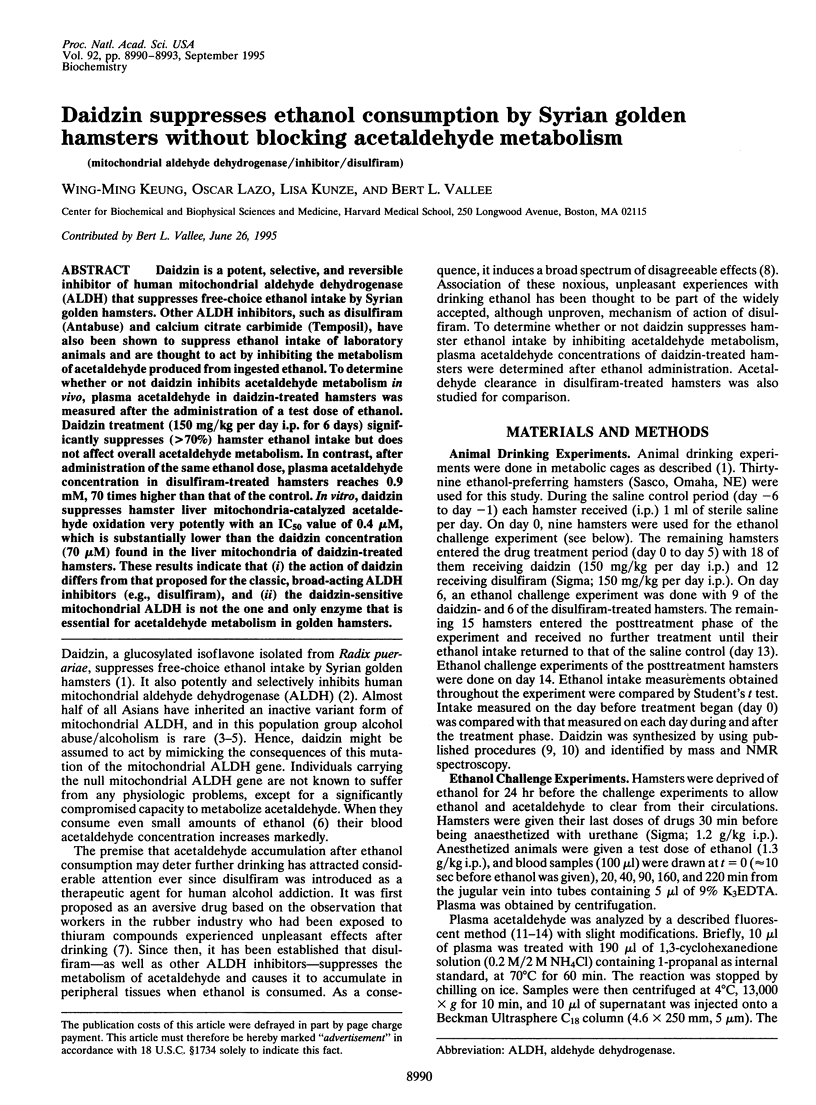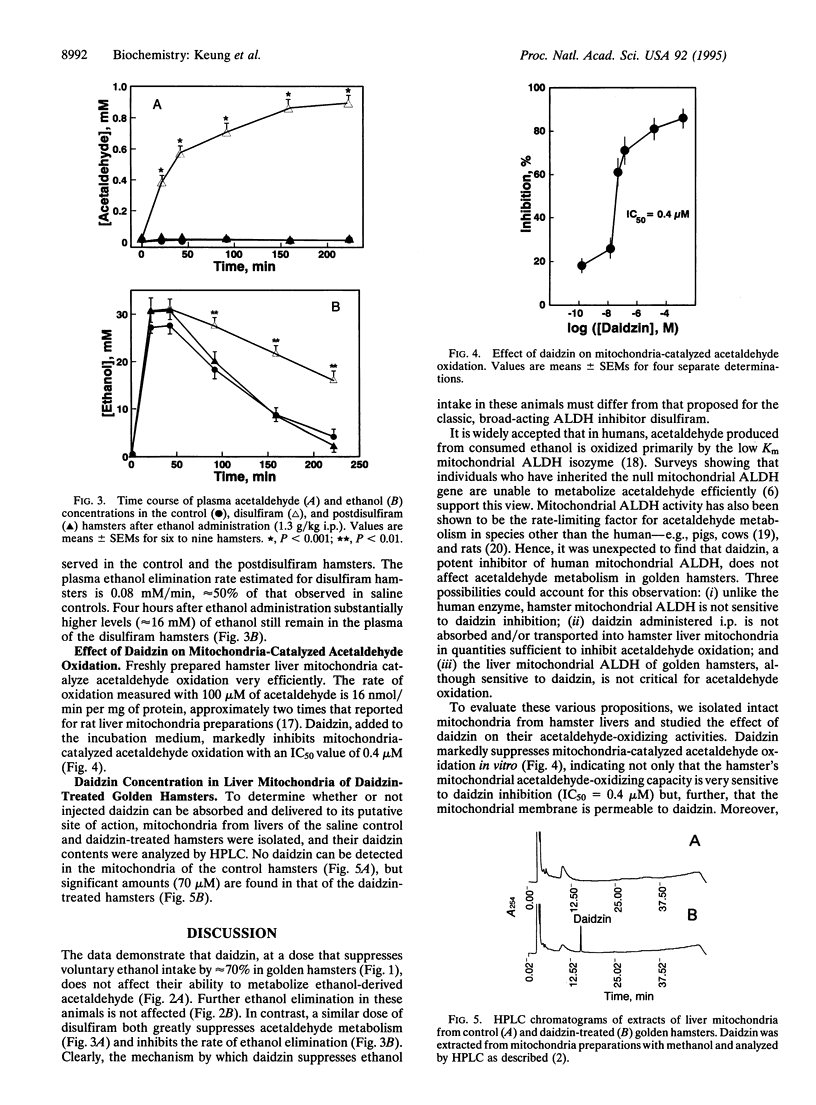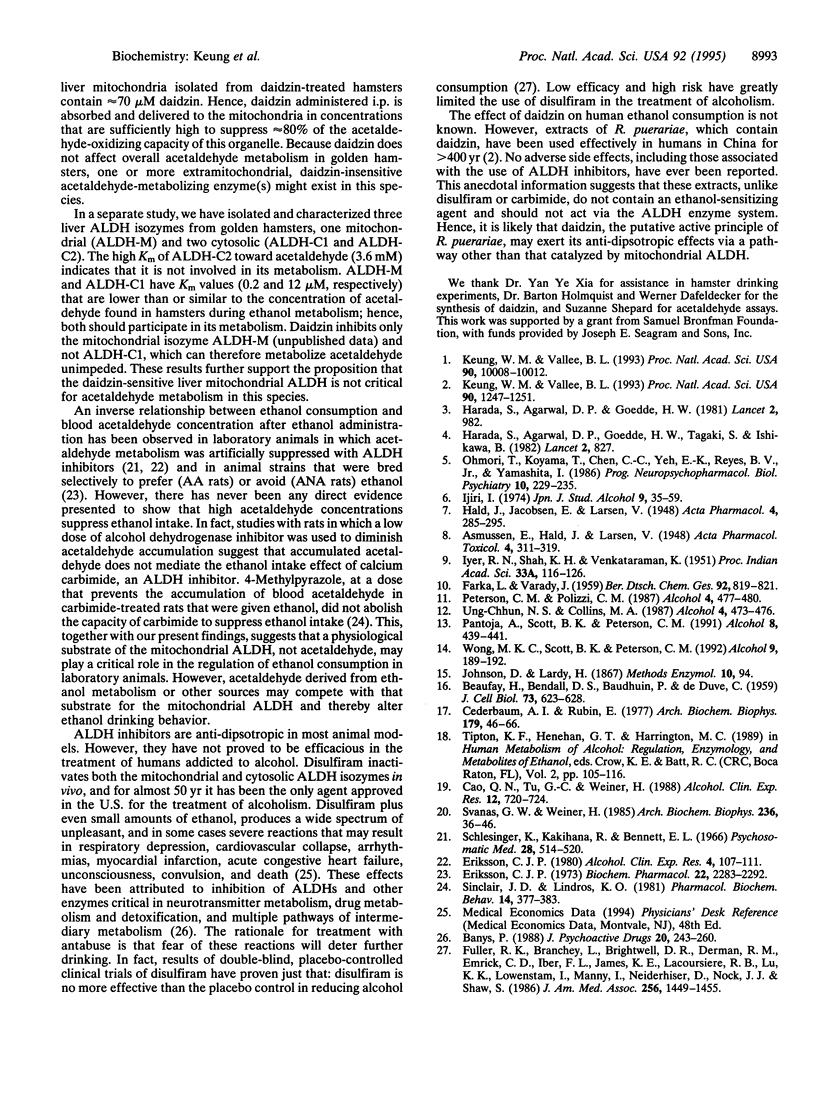Abstract
Daidzin is a potent, selective, and reversible inhibitor of human mitochondrial aldehyde dehydrogenase (ALDH) that suppresses free-choice ethanol intake by Syrian golden hamsters. Other ALDH inhibitors, such as disulfiram (Antabuse) and calcium citrate carbimide (Temposil), have also been shown to suppress ethanol intake of laboratory animals and are thought to act by inhibiting the metabolism of acetaldehyde produced from ingested ethanol. To determine whether or not daidzin inhibits acetaldehyde metabolism in vivo, plasma acetaldehyde in daidzin-treated hamsters was measured after the administration of a test dose of ethanol. Daidzin treatment (150 mg/kg per day i.p. for 6 days) significantly suppresses (> 70%) hamster ethanol intake but does not affect overall acetaldehyde metabolism. In contrast, after administration of the same ethanol dose, plasma acetaldehyde concentration in disulfiram-treated hamsters reaches 0.9 mM, 70 times higher than that of the control. In vitro, daidzin suppresses hamster liver mitochondria-catalyzed acetaldehyde oxidation very potently with an IC50 value of 0.4 microM, which is substantially lower than the daidzin concentration (70 microM) found in the liver mitochondria of daidzin-treated hamsters. These results indicate that (i) the action of daidzin differs from that proposed for the classic, broad-acting ALDH inhibitors (e.g., disulfiram), and (ii) the daidzin-sensitive mitochondrial ALDH is not the one and only enzyme that is essential for acetaldehyde metabolism in golden hamsters.
Full text
PDF



Selected References
These references are in PubMed. This may not be the complete list of references from this article.
- BEAUFAY H., BENDALL D. S., BAUDHUIN P., DE DUVE C. Tissue fractionation studies. 12. Intracellular distribution of some dehydrogenases, alkaline deoxyribonuclease and iron in rat-liver tissue. Biochem J. 1959 Dec;73:623–628. doi: 10.1042/bj0730623. [DOI] [PMC free article] [PubMed] [Google Scholar]
- Banys P. The clinical use of disulfiram (Antabuse): a review. J Psychoactive Drugs. 1988 Jul-Sep;20(3):243–261. doi: 10.1080/02791072.1988.10472495. [DOI] [PubMed] [Google Scholar]
- Cao Q. N., Tu G. C., Weiner H. Mitochondria as the primary site of acetaldehyde metabolism in beef and pig liver slices. Alcohol Clin Exp Res. 1988 Oct;12(5):720–724. doi: 10.1111/j.1530-0277.1988.tb00271.x. [DOI] [PubMed] [Google Scholar]
- Cederbaum A. I., Rubin E. The oxidation of acetaldehyde by isolated mitochondria from various organs of the rat and hepatocellular carcinoma. Arch Biochem Biophys. 1977 Feb;179(1):46–66. doi: 10.1016/0003-9861(77)90085-6. [DOI] [PubMed] [Google Scholar]
- Eriksson C. J. Ethanol and acetaldehyde metabolism in rat strains genetically selected for their ethanol preference. Biochem Pharmacol. 1973 Sep 15;22(18):2283–2292. doi: 10.1016/0006-2952(73)90009-9. [DOI] [PubMed] [Google Scholar]
- Eriksson C. J. The aversive effect of acetaldehyde on alcohol drinking behavior in the rat. Alcohol Clin Exp Res. 1980 Jan;4(1):107–111. doi: 10.1111/j.1530-0277.1980.tb04799.x. [DOI] [PubMed] [Google Scholar]
- Fuller R. K., Branchey L., Brightwell D. R., Derman R. M., Emrick C. D., Iber F. L., James K. E., Lacoursiere R. B., Lee K. K., Lowenstam I. Disulfiram treatment of alcoholism. A Veterans Administration cooperative study. JAMA. 1986 Sep 19;256(11):1449–1455. [PubMed] [Google Scholar]
- Harada S., Agarwal D. P., Goedde H. W. Aldehyde dehydrogenase deficiency as cause of facial flushing reaction to alcohol in Japanese. Lancet. 1981 Oct 31;2(8253):982–982. doi: 10.1016/s0140-6736(81)91172-7. [DOI] [PubMed] [Google Scholar]
- Harada S., Agarwal D. P., Goedde H. W., Tagaki S., Ishikawa B. Possible protective role against alcoholism for aldehyde dehydrogenase isozyme deficiency in Japan. Lancet. 1982 Oct 9;2(8302):827–827. doi: 10.1016/s0140-6736(82)92722-2. [DOI] [PubMed] [Google Scholar]
- Keung W. M., Vallee B. L. Daidzin and daidzein suppress free-choice ethanol intake by Syrian golden hamsters. Proc Natl Acad Sci U S A. 1993 Nov 1;90(21):10008–10012. doi: 10.1073/pnas.90.21.10008. [DOI] [PMC free article] [PubMed] [Google Scholar]
- Keung W. M., Vallee B. L. Daidzin: a potent, selective inhibitor of human mitochondrial aldehyde dehydrogenase. Proc Natl Acad Sci U S A. 1993 Feb 15;90(4):1247–1251. doi: 10.1073/pnas.90.4.1247. [DOI] [PMC free article] [PubMed] [Google Scholar]
- Ohmori T., Koyama T., Chen C. C., Yeh E. K., Reyes B. V., Jr, Yamashita I. The role of aldehyde dehydrogenase isozyme variance in alcohol sensitivity, drinking habits formation and the development of alcoholism in Japan, Taiwan and the Philippines. Prog Neuropsychopharmacol Biol Psychiatry. 1986;10(2):229–235. doi: 10.1016/0278-5846(86)90077-1. [DOI] [PubMed] [Google Scholar]
- Pantoja A., Scott B. K., Peterson C. M. Studies of urine-associated acetaldehyde as a marker for alcohol intake in mice. Alcohol. 1991 Nov-Dec;8(6):439–441. doi: 10.1016/s0741-8329(91)90068-8. [DOI] [PubMed] [Google Scholar]
- Peterson C. M., Polizzi C. M. Improved method for acetaldehyde in plasma and hemoglobin-associated acetaldehyde: results in teetotalers and alcoholics reporting for treatment. Alcohol. 1987 Nov-Dec;4(6):477–480. doi: 10.1016/0741-8329(87)90089-9. [DOI] [PubMed] [Google Scholar]
- Sinclair J. D., Lindros K. O. Suppression of alcohol drinking with brain aldehyde dehydrogenase inhibition. Pharmacol Biochem Behav. 1981 Mar;14(3):377–383. doi: 10.1016/0091-3057(81)90405-6. [DOI] [PubMed] [Google Scholar]
- Svanas G. W., Weiner H. Aldehyde dehydrogenase activity as the rate-limiting factor for acetaldehyde metabolism in rat liver. Arch Biochem Biophys. 1985 Jan;236(1):36–46. doi: 10.1016/0003-9861(85)90603-4. [DOI] [PubMed] [Google Scholar]
- Ung-Chhun N. S., Collins M. A. Estimation of blood acetaldehyde during ethanol metabolism: a sensitive HPLC/fluorescence microassay with negligible artifactual interference. Alcohol. 1987 Nov-Dec;4(6):473–476. doi: 10.1016/0741-8329(87)90088-7. [DOI] [PubMed] [Google Scholar]
- Wong M. K., Scott B. K., Peterson C. M. Breath acetaldehyde following ethanol consumption. Alcohol. 1992 May-Jun;9(3):189–192. doi: 10.1016/0741-8329(92)90051-b. [DOI] [PubMed] [Google Scholar]


